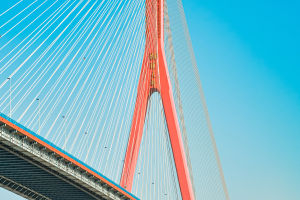
Ceramics: Evolving Artistry

The production of pottery has a history of nearly ten thousand years. Since humans began to understand pottery making, profound changes have occurred in various aspects of life.
As Engels said, "The lowest stage of the savage era began with the application of pottery." The invention of ceramic ware not only solved practical issues such as daily utensils and construction materials but also provided artistic enjoyment.
In today's world of ceramic art, modern pottery offers a refreshing experience with its innovative and unique designs and decorations. It inherits the exquisite craftsmanship of traditional pottery through the ages, blending in the modern thoughts and concepts of contemporary ceramic artists. Simultaneously, it breaks through the traditional methods of ceramic expression, utilizing diverse materials and multiple forms of presentation for artistic creation. Ceramic art boasts a rich history and a fine tradition.
Related
 Bridges: Nature's Harmony in Civilization.
Bridges: Nature's Harmony in Civilization.
 Nature's Marvels: Fuji, Namib, Etna, Rajasthan's Rich Tapestry.
Nature's Marvels: Fuji, Namib, Etna, Rajasthan's Rich Tapestry.
 Aesthetics' dance: circles vs. lines, form defies function, beauty's paradox explored.
Aesthetics' dance: circles vs. lines, form defies function, beauty's paradox explored.
 World's Unique Bridge Marvels in Brief
World's Unique Bridge Marvels in Brief
 Music's primal magic: emotion, reward, and sensory symphony.
Music's primal magic: emotion, reward, and sensory symphony.
 There is no such thing as a perfectly symmetrical snowflake, nor are there two identical snowflakes.
There is no such thing as a perfectly symmetrical snowflake, nor are there two identical snowflakes.
In contemporary pottery creation, the guiding principle involves assimilating the essence while discarding the obsolete. It employs traditional ceramic techniques in conjunction with modern forms for artistic refinement, employing various techniques to decorate different ceramic works.
Drawing inspiration from contemporary sculpture and murals, it creates distinctive textures on the clay body and glaze surfaces, merging modern forms with traditional decorative themes. Through new compositions and depictions, it crafts unique visual effects from the perspectives of form, texture, pattern, and meaning.
Ceramics serve both utilitarian and artistic purposes. Humans mold and manipulate clay according to their needs, using ceramics to create nearly anything, adapting to their evolving requirements. People don't merely seek the utilitarian value of ceramics; they also regard it as an aesthetic object, a decorative display, embodying aesthetic tastes in ceramic art and showcasing imaginative creativity in ceramic craftsmanship.
Ceramics occupy a unique place in the realm of art, seamlessly bridging the gap between life and art. There seems to be no other object that integrates utility and aesthetics as perfectly as ceramics. Ceramics encompass both pottery and porcelain. Broadly speaking, ceramics include pottery, porcelain, and stoneware. Ceramics find wide application in daily life, decorative arts, environmental embellishments, and architectural adornments, and hold significant utility in modern industries such as chemicals, power, and machinery.
Based on functionality, ceramics are categorized into practical utensils, decorative pieces, distinguished ceramics, ceramic toys, ceremonial ceramics, and architectural ceramics. Originally, ceramics were not created for art but for utility, where their artistic and practical aspects were initially aligned. Gradually, a distinction emerged between purely utilitarian ceramics and ornamental ceramics, consciously delineating ceramics created for art and those for practicality.
Initially, ceramics weren't considered artistic, but through development, they acquired artistic qualities. Furthermore, ceramic art stands as one of humanity's earliest and most vital art forms.

Ceramics serve as a ubiquitous yet crucial vessel for cultural transmission. Through generations of ceramic artifacts, human wisdom and cultural significance are "preserved" and passed down, maintaining an unbroken chain of cultural history. From this perspective, ceramics serve as another symbolic representation of human life, unmatched by any other artifact.
In essence, ceramics stand as a testament to human ingenuity and cultural evolution. From its humble origins in pottery-making to its elevation as a refined art form, ceramics encapsulate the fusion of functionality and aesthetics.
As an enduring symbol of human creativity, ceramics continue to bridge the gap between practicality and artistic expression, weaving a narrative of our cultural heritage through the ages. With its timeless appeal and versatile nature, ceramics persist as an unparalleled embodiment of human endeavor, shaping our past, present, and future cultural landscapes.